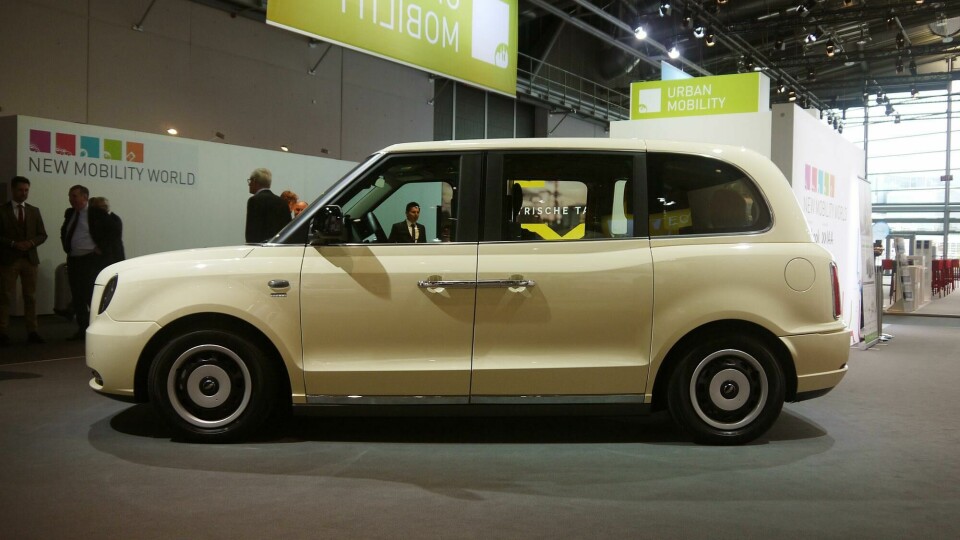
Frankfurt 2017: TX London Taxi
The new cab for the British capital has the tough job of revitalising an icon. David Ancona, design director & general manager of Geely Design Barcelona, the studio responsible for the TX, spoke to Car Design News
Tucked away in a corner of the Frankfurt motor show, a few miles outside of its natural habitat, we found the latest London black cab. It’s built by the London Taxi Company – now rechristened the London Electric Vehicle Company (LEVC), reflecting the new TX model’s petrol-electric powertrain and owned by Chinese manufacturer Geely, which of course also owns Volvo.
The new cab is built using an aluminium frame onto which composite panels are bonded. Under the skin, there’s an electric motor at the back driving the rear wheels, a battery under the raised floor of the front section of the cabin, and a three-cylinder petrol engine under the bonnet, providing long-range running beyond the 70 or so miles enabled by the battery. A choice of Chademo and CCS charging sockets are hidden behind twin flaps either side of the front grille.

We climbed into the new six-seat passenger compartment with Peter Horbury, senior vice president of Geely Design, and David Ancona, design director & general manager of Geely Design Barcelona, the studio responsible for the TX.
CDN: What were the biggest challenges in designing the TX?
David Ancona: “Packaging was the really tricky thing. It had to be the same width across the mirrors as today’s TX4, which is only a five-seater and only then if you’re really friendly. The new car had to be a full six-seater, which meant we had to find extra width inside, despite the aluminium structure, which tends to be bulkier than steel structure. So it was difficult.
“The mirrors are a more upright type, which means we’ve got the same distance [across the mirrors] but the body has moved out.”
Peter Horbury: “We went through a few iterations. The demonstrator we showed earlier in the year was extremely vertical at the sides, and that made it look almost as if it was growing outwards at the top. Working with the engineers we’ve since managed to add a few degrees of tumblehome. It was hard work, but we managed it.
“Ensuring it still looked like a London Taxi also meant giving it some shape, outside of the glass planes, to give it a shoulder. So there was a lot of discussion about how much shoulder we could actually get, to give a three-dimensional quality to the design and not just end up with a van-like box.”
David Ancona: “We used every trick in the book. We used chrome and blacked-out pillars to try to get as much horizontal impact as possible, and to help give it a shoulder. And instead of a big haunch there’s just a hint of it there, and a light-catcher lower down, just to try and stretch the visuals horizontally.”

CDN: Compared to previous London Taxi designs, there’s also quite a big front overhang to deal with…
Ancona: “We had to have that for crash requirements. This is a new ball game for the taxi. And with the tight turning circle [a London cab must be able to U-turn between walls 28 feet apart], this meant the corners had to be cut off, so it’s a bit of a thru’penny bit at the front. The first few goes in 3D looked like an elephant seal.
“We’ve tried to come back from the grille progressively, pulling the lights back just enough so that you didn’t read this big extent of front overhang.”
CDN: What have you tried to achieve with the surface treatment?
Ancona: “We wanted to give it a more contemporary feel. The problem with the TX4 is it’s like a taxi that’s been designed for Wallace & Gromit. It’s a bit over-inflated, a bit like a hedgehog. We wanted to get away from that. The reference for this car was the old FX4, which has much more horizontal lines.
“We didn’t want it to look too aggressive, or too cute, or too retro. It had to look serious, friendly and reliable. It also had to look new but not radical. A piece of radical design is only going to date very quickly, whereas these things have a working life of 15 to 20 years.”










